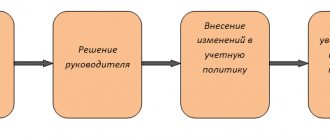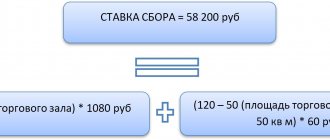Object of taxation of trade tax
The trade fee is established in relation to the implementation of trading activities at trading facilities (clauses 1, 2 of Article 413 of the Tax Code of the Russian Federation). Trading activities include the following types of trade:
- trade through facilities of a stationary retail chain that do not have sales floors (with the exception of such facilities that are gas stations);
- trade through objects of a non-stationary trading network;
- trade through stationary retail chain facilities with trading floors;
- trade carried out by releasing goods from a warehouse.
The object of trade is recognized as: a building, structure, premises, stationary or non-stationary retail facility or retail outlet, with the use of which the payer carries out the type of activity in respect of which the fee is established (clause 4 of Article 413 of the Tax Code of the Russian Federation).
Chapter 33 “Trade fee” of the Tax Code of the Russian Federation does not decipher the concepts of “facility of a stationary retail chain”, “facility of a non-stationary retail chain”, “area of a retail facility”.
Officials recommended using the definitions given in Article 2 of the Federal Law of December 28, 2009 No. 381-FZ “On the Fundamentals of State Regulation of Trade Activities in the Russian Federation” (hereinafter referred to as Law No. 381-FZ).
Retail zones
A retailer company operates in a trading space common to all, while it is surrounded by its own trading zone, which we will further call the retail zone. In general, this is the territory in which sellers of goods or services and their buyers are located. Professor Huff gives the following definition of a retail zone - “a geographic sector that contains potential consumers who (with a probability greater than zero) can purchase a certain type of product offered to them by trading companies.”
It is generally accepted that the retail zone consists of basic, secondary and peripheral parts. D. Gilbert, in his theory of market area, gives a detailed description of the geographical location of the outlet. He proposes the following definition: a retail zone is the geographic area in which potential customers of an individual retailer are located. The essence of his theory is that inside (in the center) of the market area there is a retail outlet, and around it three zones can be distinguished: basic, secondary, and peripheral.
The difference between these zones is the distance and time required to get to the outlet (store). In works devoted to this issue, it is usually assumed that approximately 60 - 80% of buyers live in the base zone. The radius of this zone is 4-5 km. An important thing for this zone is the fact that within its boundaries there is almost no intersection with the trading areas of competitors. About 15-20% of buyers live in the secondary zone, its radius is 6 - 8 km and within its limits there is less density and slightly greater overlap with competitors’ zones.
The marginal zone includes all other buyers. Usually these are those who are willing to travel a long distance (9-12 km) in order to get to a certain store.
This division is found quite often in the literature, however, with the development of retail, it no longer seems so clearly correct. Even in conditions of a relatively low density of retail chains in Russia by world standards, it is difficult to imagine that within a radius of 4-5 km there would be little overlap with competitors’ zones. In this situation, taking into account the rapid development of the “store at home” format, the following division of retail zones seems more correct [24, p. 71-72]:
— basic – 0.1-1 km, an area in which it is profitable to develop the “convenience store” format. Walking distance or up to 10 minutes drive;
– secondary – 1-5 km. Approximately 10-20 minutes by transport;
- outlying - 5-9 km. Over 20-30 minutes by transport.
Although, in practice, to determine the size of the retail zone , companies usually conduct special studies that take into account the specifics of the format, etc., in the theoretical literature, such a method for determining the retail zone as the Reilly-Converse law is very popular and studied. The idea of this method is to find a point between two shopping areas at which consumers do not care which store they prefer and where to make a purchase, the so-called. point of indifference. The main assumption of this model is that a large object (or in our case a store) attracts more customers than a small one, because it has a wider range of goods, which justifies the increased time spent on shopping.
In addition to external geographical location, internal trading space plays an important role. How the product is accessed and possible sales technologies depend on its characteristics. The two main elements of the internal space for food retailers are: the sales floor and the goods area (warehouse). The sales floor refers to the place where goods are located and the purchase and sale transaction takes place between the seller and buyers. The most important area of research in this area is the pattern of customer movement around the store. Goods area is a place where goods are stored that are not yet displayed for sale on the sales floor. The most important area of research is the optimization of warehouse space and inventory levels. Internal space, and in particular: its size, the way goods are laid out, the level of service, the breadth and depth of the assortment, largely explains the differences between retail formats.
Stationary object
A stationary retail facility is an object that is a building or part of a building, structure or part of a building (Article 2 of Law No. 381-FZ):
- firmly connected by the foundation of such a building or structure to the ground;
- connected (technologically connected) to engineering support networks.
Let us note that the concept of “stationary distribution network” is in Chapter 26.3 of the Tax Code of the Russian Federation, dedicated to UTII: “stationary distribution network is a distribution network located in buildings, structures, structures connected to utilities intended and (or) used for trading” (Article 346.27 of the Tax Code of the Russian Federation). As you can see, the differences are not fundamental. However, there is no reference to this norm in the commented explanation No. SD-4-3/ [email protected] .
Non-stationary object
Non-stationary retail facility - a retail facility that is a temporary structure or temporary structure that is not firmly connected to the land plot, regardless of the presence or absence of a connection (technological connection) to engineering support networks. In particular, mobile structures are classified as non-stationary objects (Article 2 of Law No. 381-FZ).
Let’s compare it with the definition used for the purposes of UTII: “non-stationary trading network - a trading network operating on the principles of distribution and distribution trade, as well as objects of trade organization that are not classified as a stationary trading network” (Article 346.27 of the Tax Code of the Russian Federation). But these definitions are already different.
Let us recall that UTII and trade tax have different objects of taxation (respectively, imputed income and the object of trade).
Retail trade and PSN
PSN is a tax regime in which for tax purposes it is not the income actually received that is taken into account, but the potentially possible one, i.e. supposed. For retail, the tax amount is calculated based on the area of the store or the number of retail facilities. For small stores conducting only retail trade, this regime turns out to be quite fair, including taking into account the interests of the budget.
But if, for example, 30 sq. m to conduct wholesale trade, then the turnover of such a store can amount to more than one million rubles a day, and the tax will be scanty. Applying the same components of the tax calculation formula to wholesale trade as for retail trade will be incorrect both in relation to other taxpayers and for replenishing the budget. That is why tax inspectorates always ensure that PSN payers do not replace retail trade with wholesale trade. How do tax authorities come to the conclusion that instead of retail trade, the PSN payer conducts wholesale trade?
1. Wholesale trade is formalized by a supply agreement, therefore, if the PSN payer concludes such an agreement with the buyer, then the sale will definitely be recognized as wholesale, with the corresponding additional taxes being charged according to the general taxation system. But even if the agreement is called a retail purchase and sale agreement, and it stipulates a certain range of goods and the period for their delivery to the buyer, then such trade is also recognized as wholesale. This position is expressed in the Resolution of the Presidium of the Supreme Arbitration Court of the Russian Federation dated 04.10.11 No. 5566/11.
In general, a retail purchase and sale agreement is a public contract, and its conclusion does not require a written document, but rather a cash receipt or sales receipt. If the buyer asks you for a written purchase and sale agreement, explaining that he wants to take these expenses into account in his costs, then this is the use of the goods for business purposes, which means that the PSN payer, concluding such an agreement with the buyer, risks being subject to additional taxes and fines.
2. The main criterion for the separation of wholesale and retail trade, as we have already found out, is the final purpose of the buyer’s use of the purchased product. Although the seller is not obliged to monitor the further use of the goods by the buyer, there are goods whose characteristics clearly indicate their use in business activities: commercial, dental, jewelry and other equipment, cash registers and receipt printing machines, office furniture, etc.
In addition, Article 346.43 (clause 3) of the Tax Code of the Russian Federation provides a list of goods, the sale of which is not recognized as retail trade permitted under the PSN, in particular:
- some excisable goods (passenger cars, motorcycles with a power of more than 150 hp, gasoline, diesel fuel, oils);
- food, drinks, alcohol in catering facilities;
- trucks and buses;
- special vehicles and trailers;
- goods based on samples and catalogs outside the stationary distribution network (online stores, postal catalogs).
3. In some cases, tax inspectorates conclude that trade is wholesale only for the category of buyer - individual entrepreneur and organization, although such a conclusion is often refuted by the courts. As for such budgetary institutions as schools, kindergartens, hospitals, in relation to them trade can be recognized as wholesale not on the basis of the use of purchased goods in business activities, but on the basis of supply contracts.
4. The method of payment - cash or non-cash - is not an unambiguous indication of wholesale trade. A retail buyer has the right to pay the seller either in cash or by bank card, or by transfer to a bank account. However, payment by transfer to the seller's account is often assessed as indirect evidence of wholesale trade.
Thus, it is safer for PSN payers to adhere to the following points when selling goods:
- Do not enter into a written sales contract with the buyer, but issue a cash or sales receipt;
- Sell goods on the premises of the store, and not by delivering it to the buyer;
- Do not issue invoices and delivery notes to the buyer;
- Accept payment in cash or card.
If among your customers there are not only ordinary individuals, then it is easier to work on the simplified tax system. In this case, you do not risk receiving a recalculation of taxes under the general taxation system.
When you don't have to pay a sales tax
The Tax Service has indicated that trading is not subject to tax if the office in which it is carried out:
- does not meet the requirements for a retail facility given in Article 2 of Law No. 381-FZ;
- cannot be recognized as a building, structure, premises or retail outlet.
For example, organizations and individual entrepreneurs engaged in retail or wholesale trade through open areas are not recognized as payers of the trade tax.
At the same time, if temporary structures used for trading are located on an open area, such an open area is a non-stationary trading facility and is subject to a trade tax. This clarification is contained in the letter of the Ministry of Finance of Russia dated October 14, 2015 No. 03-11-09/58630.
The reasoning is similar. Officials pointed out that the concept of a trading facility in the form of an open area, which, according to Article 346.27 of the Tax Code of the Russian Federation, is a place specially equipped for trading, located on a land plot, is not given by Chapter 33 of the Tax Code of the Russian Federation and Law No. 381-FZ.
Bukhgalteriya.ru recommends
Invaluable experience in solving current problems, answers to complex questions, specially selected latest information in the press for accountants and managers. Magazines for accountants and entrepreneurs >>




